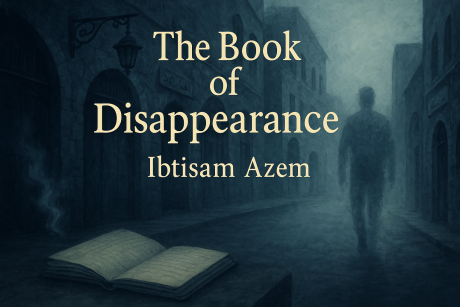Book of Disappearance by Ibtisam Azem
BOOKS REVIEW
Chaifry
7/18/20257 min read


Ibtisam Azem, a Palestinian novelist and journalist born in Taybeh, northern Jaffa, crafts a haunting speculative narrative in her second novel, The Book of Disappearance, translated from Arabic by Sinan Antoon. Originally published in 2014 by Dar al-Jamal in Beirut and brought to English readers in 2019 by Syracuse University Press, this novel poses a provocative question: “What if all the Palestinians in Israel simply disappeared one day?” (Azem, 2019, p. 1). Set in contemporary Tel Aviv and Jaffa, the novel explores the aftermath of the inexplicable overnight vanishing of all Palestinians, weaving together themes of memory, loss, identity, and the enduring legacy of the 1948 Nakba.
Azem, a descendant of Nakba survivors, draws on her heritage to create a work that is both a poignant meditation on absence and a searing critique of settler-colonial narratives, earning accolades such as a longlist nomination for the 2025 International Booker Prize.
This review argues that The Book of Disappearance is a vital read for its audacious speculative premise, lyrical prose, and unflinching examination of the Palestinian experience, offering a lens into the psychological and sociopolitical costs of erasure. Its innovative structure and emotional depth make it a compelling addition to global literature, particularly for readers seeking to understand the human dimensions of historical conflicts. For Indian readers, the novel resonates with narratives of partition, displacement, and resilience, drawing parallels with works by regional authors like Amrita Pritam and Perumal Murugan. Its universal themes of memory and resistance against cultural obliteration make it essential reading for anyone invested in justice, identity, and the power of storytelling.
The Book of Disappearance unfolds over 48 hours in Tel Aviv and Jaffa, where the sudden, unexplained disappearance of all Palestinians—citizens, workers, and prisoners alike—plunges Israeli society into disarray. The narrative alternates between two primary voices: Alaa, a Palestinian cameraman in Tel Aviv, who reflects on his late grandmother’s Nakba experiences through a red notebook, and Ariel, his Jewish Israeli neighbor and friend, a journalist grappling with the void left by the disappearance. Alaa’s journal entries, addressed to his grandmother, evoke Jaffa’s pre-1948 vibrancy: “Your Jaffa resembles mine. But it is not the same. Two cities impersonating each other” (Azem, 2019, p. 17). Ariel, a liberal Zionist critical of the occupation yet tethered to Israel’s national myth, navigates the chaos, noting, “The city felt like a ghost town, but the ghosts were invisible” (Azem, 2019, p. 45).
The novel opens with Alaa mourning his grandmother’s death, her memories of displacement shaping his identity: “When I walk in Palestine, it’s as if I walk over corpses” (Azem, 2019, p. 63). Her stories of Jaffa’s orange groves and lost homes anchor his narrative, which Ariel discovers after Alaa vanishes. As Ariel investigates, he observes societal reactions ranging from confusion to opportunism: “Some celebrated, as if a burden had been lifted” (Azem, 2019, p. 80). Café patrons, radio commentators, and farm owners reveal a spectrum of responses, from anxiety over absent workers to the swift appropriation of Palestinian properties, echoing historical dispossessions. A farm owner laments, “They’re not on strike. They’re just… gone” (Azem, 2019, p. 102).
Alaa’s notebook recounts personal and collective trauma, blending his grandmother’s tales with his own reflections: “I wish you were here. Missing you is like a rose of thorns” (Azem, 2019, p. 33). Ariel’s chapters, written in a journalistic style, expose the fragility of Israel’s myths, as he admits, “I thought I knew this place, but now it feels like a lie” (Azem, 2019, p. 120). The novel intersperses vignettes of ordinary lives—flower-cutters, shopkeepers—highlighting the void left by Palestinians: “Their absence was louder than their presence ever was” (Azem, 2019, p. 150). A haunting painting in Alaa’s apartment, depicting a figure in a keffiyeh, becomes a symbol of enduring witness, as Ariel notes, “It stared at me, as if it knew something I didn’t” (Azem, 2019, p. 175).
The narrative builds to a climax where Ariel, sleeping in Alaa’s apartment, hears mysterious noises: “A rattling, a whispering, as if the walls were speaking” (Azem, 2019, p. 200). The unresolved disappearance underscores the novel’s speculative core, refusing to explain the supernatural event, instead focusing on its emotional and political ripples. Through Alaa’s memories and Ariel’s reckoning, Azem crafts a dialogue between presence and absence, challenging readers to confront the ongoing Nakba’s legacy.
Azem’s The Book of Disappearance is a tour de force of speculative fiction, blending magical realism with incisive political commentary. Its premise—the sudden vanishing of Palestinians—is audacious, serving as a “powerful metaphor” for the historical erasure of Palestinian identity (Azem, 2019, p. 2). The novel’s structure, alternating between Alaa’s lyrical notebook and Ariel’s detached reportage, creates a dynamic interplay that mirrors the tension between personal memory and systemic denial. Alaa’s entries are particularly evocative, his grandmother’s stories breathing life into Jaffa’s lost world: “Your Jaffa resembles mine. But it is not the same” (Azem, 2019, p. 17). This vivid psycho-geography, praised as “haunting and deeply humane”, grounds the speculative in tangible loss, making the novel a poignant elegy for Palestine.
Azem’s prose, rendered with “pure, measured” precision by Sinan Antoon, balances emotional depth with restraint. Alaa’s reflections, such as “When I walk in Palestine, it’s as if I walk over corpses” (Azem, 2019, p. 63), resonate with the visceral pain of displacement, akin to Mahmoud Darwish’s poetry. Ariel’s character, a liberal Zionist whose contradictions unravel, is a masterstroke, exposing the fragility of “progressive” ideologies that uphold colonial structures. His realization, “I thought I knew this place, but now it feels like a lie” (Azem, 2019, p. 120), dismantles the myth of coexistence without preaching, a subtlety reviewers laud as “brilliantly conceived”.
The novel’s vignettes of societal reactions—celebration, anxiety, appropriation—offer a kaleidoscopic view of Israeli society, revealing its dependence on Palestinian labor and presence: “Their absence was louder than their presence ever was” (Azem, 2019, p. 150). This mirrors Indian partition narratives, where absence reshapes communal identities, as seen in Amrita Pritam’s Pinjar. Azem’s refusal to explain the disappearance enhances its speculative power, aligning with works like José Saramago’s Blindness, forcing readers to focus on consequences rather than causes. For Indian readers, the novel’s exploration of memory and resistance echoes Perumal Murugan’s One Part Woman, where societal pressures fracture personal bonds.
Despite its strengths, The Book of Disappearance has limitations. The narrative’s flow can feel disjointed, with abrupt shifts between Alaa’s introspective entries and Ariel’s journalistic observations disrupting emotional continuity. Some readers note a “lack of flow”, as the vignettes, while vivid, occasionally dilute the focus on the central characters. Ariel’s character, though complex, risks becoming a caricature of liberal Zionism, his moral ambiguity underexplored in later chapters. His act of appropriating Alaa’s apartment, while symbolic, feels heavy-handed, as he notes, “It stared at me, as if it knew something I didn’t” (Azem, 2019, p. 175), but lacks deeper introspection to fully humanize his flaws.
The speculative premise, while bold, may alienate readers seeking resolution, as the unexplained disappearance feels like a “one-trick magical realism move”. For Indian readers, the novel’s Western setting and focus on the Israeli-Palestinian conflict may limit cultural relatability, unlike Vaikom Muhammad Basheer’s Balyakalasakhi, which grounds moral complexity in Malayalam contexts. The prose, though lyrical, occasionally leans on repetitive imagery, such as Alaa’s fixation on Jaffa’s orange groves, which risks sentimentality. Additionally, the novel’s political undertones may feel overly didactic to readers unfamiliar with the Nakba, potentially preaching to those already aligned with Palestinian perspectives.
Why Indian Readers Must Read This Book
The Book of Disappearance is a vital read for Indian audiences, resonating with the subcontinent’s history of partition, displacement, and cultural erasure. Alaa’s lament, “I wish you were here. Missing you is like a rose of thorns” (Azem, 2019, p. 33), echoes the pain of families torn apart during India’s 1947 partition, as depicted in Amrita Pritam’s Pinjar, where Punjabi women navigate loss under patriarchal and communal pressures. The novel’s exploration of memory as resistance, embodied in Alaa’s notebook, parallels Perumal Murugan’s One Part Woman, where Tamil traditions clash with societal expectations, fracturing personal identities. Azem’s focus on a stolen homeland, where “two cities impersonate each other” (Azem, 2019, p. 17), mirrors the contested identities of Kashmir or Assam, where historical narratives are overwritten by dominant powers.
The societal reactions to the disappearance—opportunistic appropriation and denial—reflect India’s own struggles with communal tensions and the marginalization of minorities, akin to the erasure of indigenous voices in Vaikom Muhammad Basheer’s Balyakalasakhi. Ariel’s conflicted liberalism, as he admits, “I thought I knew this place, but now it feels like a lie” (Azem, 2019, p. 120), resonates with Indian readers grappling with the contradictions of secularism in a polarized society. The novel’s speculative premise, where “their absence was louder than their presence ever was” (Azem, 2019, p. 150), invites reflection on the invisibility of marginalized communities in India, from Dalits to Adivasis.
For Indian thriller and literary fiction fans, Azem’s blend of suspense and lyrical prose offers a gripping yet introspective experience, comparable to Anuradha Roy’s All the Lives We Never Lived. Its short, evocative chapters, as Ariel hears “a rattling, a whispering, as if the walls were speaking” (Azem, 2019, p. 200), make it accessible to India’s growing readership. The novel’s call to preserve memory through storytelling aligns with India’s oral traditions, making it a powerful read for those seeking to understand resilience and justice in the face of erasure.
The Book of Disappearance is a haunting, audacious work that transforms a speculative premise into a profound meditation on memory, loss, and resistance. Azem’s lyrical prose and dual narrative structure weave a tapestry of personal and collective trauma, making the absence of Palestinians a powerful metaphor for the ongoing Nakba. Its strengths—evocative storytelling, complex characters, and socio-political depth—outweigh its minor flaws, such as occasional narrative disjointedness and didactic undertones. The novel’s resonance with Indian experiences of displacement and cultural erasure, alongside its universal themes, makes it essential reading. For Indian readers, it offers a lens into shared struggles, echoing the works of Pritam, Murugan, and Basheer. I wholeheartedly recommend The Book of Disappearance to anyone seeking a thought-provoking, emotionally resonant exploration of identity and justice, urging readers to confront the silences that shape our world.
